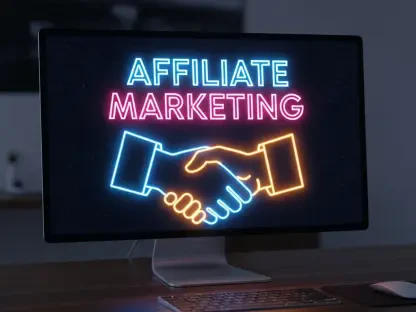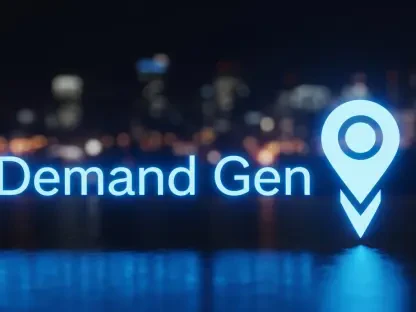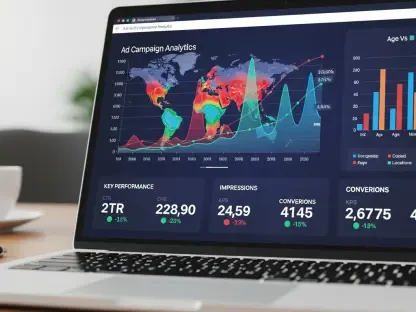In the fast-paced realm of digital advertising, staying ahead demands tools that blend reach with precision, especially when millions of drivers use apps like Waze daily to find nearby businesses. Meanwhile, advertisers often struggle with unclear data on where their ads appear across vast networks, highlighting a critical challenge and opportunity. This intersection sets the stage for a deep dive into Google’s latest enhancements to Performance Max (PMax) campaigns. This roundup gathers diverse perspectives from industry voices, dissecting how Waze ad integration and advanced channel reporting are reshaping advertising strategies. The purpose here is to compile varied opinions and actionable tips, offering a panoramic view of these updates and their potential to transform omnichannel marketing.
Diverse Perspectives on PMax Innovations
Waze Ad Integration: Driving Real-World Results
Insights from digital marketing strategists highlight the groundbreaking addition of Waze ad inventory to PMax, particularly through “Promoted Places in Navigation” pins targeting U.S. drivers. Many see this as a timely move to boost store visits, leveraging existing creative assets for seamless campaign execution. The consensus points to a significant advantage for retailers aiming to capture attention during key decision-making moments on the road.
Contrasting views emerge on user experience, however. Some industry observers caution that ads during navigation must strike a delicate balance to avoid distracting drivers, emphasizing the need for relevance over intrusion. Others express optimism about Google’s ability to refine this feature, noting its strategic rollout ahead of peak holiday travel seasons as a testbed for broader impact.
A third angle focuses on scalability, with experts intrigued by the planned global expansion slated for completion by 2027. While enthusiasm abounds for tapping into location-based marketing, there’s a shared concern about regional differences in driver behavior and market readiness. This diversity of thought underscores the need for tailored approaches as the feature extends beyond U.S. borders.
Enhanced Channel Reporting: Clarity or Complexity?
Turning to PMax’s new channel performance reporting, industry analysts largely applaud the inclusion of data from Search partners, seeing it as a long-overdue step toward transparency. For advertisers managing multiple accounts via Marketing Client Centers (MCC), this update promises clearer insights into ad placements across Google’s network, enabling more informed budget allocations.
However, not all feedback is uniformly positive. Some digital ad specialists warn of potential data overload, suggesting that while automation simplifies execution, the influx of granular metrics might overwhelm smaller teams lacking robust analytical resources. This viewpoint stresses the importance of user-friendly dashboards to make the data actionable rather than burdensome.
A balanced perspective comes from campaign optimization experts who argue that this reporting enhancement positions PMax competitively against rival platforms offering detailed insights. They note that while the update addresses past criticisms of opacity, it also raises expectations for even deeper control over ad placements, hinting at an ongoing evolution in advertiser demands.
Omnichannel Ambitions: Merging Online and Offline
The Waze partnership is often cited as a bold leap toward true omnichannel advertising, blending digital touchpoints with physical outcomes. Marketing thought leaders praise this integration for redefining full-funnel strategies, where online ads directly influence in-store traffic. This synergy is seen as a game-changer for industries reliant on foot traffic, like retail and hospitality.
Differing opinions surface regarding ease of adoption. Some industry watchers point out that while automation aims to streamline campaign management, merging platforms like Waze with PMax could introduce complexities for advertisers unfamiliar with location-based nuances. They advocate for comprehensive training resources to bridge this gap.
Another layer of discussion explores global implications, with analysts projecting varied reception based on regional driving patterns and technological infrastructure. As the rollout progresses through 2027, there’s a call for Google to adapt strategies to local contexts, ensuring that the omnichannel promise doesn’t falter in diverse markets.
Addressing Advertiser Needs: Data as a Double-Edged Sword
Google’s broader push to tackle PMax’s historical transparency issues garners significant attention, with many in the ad community appreciating complementary updates like bulk reporting and segmentation introduced earlier this year. These tools, paired with channel reporting, are viewed as a direct response to advertiser feedback, fostering trust in automated systems.
Skeptics, however, question whether these enhancements fully close transparency gaps. A segment of industry voices suggests that while actionable data is a step forward, it might fuel demands for even more granular control, potentially clashing with PMax’s automation-first ethos. This tension between autonomy and oversight remains a hot topic.
An additional perspective emphasizes the psychological impact on advertisers. Some believe that clearer analytics not only improve campaign outcomes but also rebuild confidence in Google’s ad tools, especially for those previously frustrated by vague performance metrics. This emotional dimension adds depth to the discussion of data-driven advertising.
Key Takeaways from the Roundup
Reflecting on this collection of insights, it becomes clear that Google’s updates to PMax through Waze integration and enhanced reporting have stirred both excitement and critical debate among industry players. The dual focus on immediate gains, like driving store visits via navigation ads, and strategic refinements through detailed data, emerged as pivotal advancements. Differing views on user experience, complexity, and global scalability painted a nuanced picture of potential and pitfalls.
Looking ahead, advertisers are encouraged to experiment with Waze-driven campaigns in targeted U.S. markets while leveraging new reporting insights to optimize budgets across channels. A practical next step involves testing seasonal campaigns to capitalize on holiday traffic spikes, ensuring data guides every pivot. Additionally, staying informed about global rollout plans through 2027 offers a chance to prepare for expanded opportunities, positioning early adopters to refine location-based strategies ahead of competitors.









